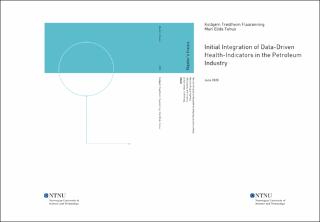| dc.contributor.advisor | Vatn, Jørn | |
| dc.contributor.author | Flaarønning, Kolbjørn Trøstheim | |
| dc.contributor.author | Tuhus, Mari Elida | |
| dc.date.accessioned | 2021-09-24T18:13:40Z | |
| dc.date.available | 2021-09-24T18:13:40Z | |
| dc.date.issued | 2020 | |
| dc.identifier | no.ntnu:inspera:57228183:31910936 | |
| dc.identifier.uri | https://hdl.handle.net/11250/2781670 | |
| dc.description.abstract | Tilstandsovervåkning har blitt en essensiell vedlikeholdsstrategi i flere bransjer. Muligheten til å samle systemdata om helsetilstanden til komponenter gjør det mulig å redusere driftskostnader betraktelig, samt redusere risikoen for katastrofale hendelser. Med dagens teknologiske framskritt er det mulig å installere sensorer på og overvåke alle tenkelige gjenstander. Sensorteknologi generer en enorm mengde data, noe som gir en verdifull innsikt hvis den tolkes korrekt. Ettersom data fra industrien ofte er ufullstendig, inkonsistent og inneholder støy, kreves det sofistikerte strategier ved datainnsamling og dataprosessering, samt avanserte prediktive fremgangsmåter. Denne masteroppgaven foreslår implementering av datadrevne modeller for å øke den prediktive evnen i vedlikeholdsstrategien til Teekay Offshore Production. En helseindikator som overvåker kompressorer, turbiner og dieselmotorer krever en omfattende innsamling av data. Derfor er det lagt et stort fokus på å sikre høy datakvalitet ved å utføre omfattende tester av ulike databehandlingsmetoder. Tre recurrent neural networks, samt to baseline-modeller, henholdvis en klassisk statistisk modell og et flerlags perceptron, er implementert. Baseline-modellene sikrer muligheten til å vurdere verdien av å øke kompleksiteten på modellene. Recurrent neural networks modellene presterte bedre enn samtlige baseline-modeller, hvor long-short term modellen skilte seg spesielt ut med en relativ forbedring på 17.18%. Til slutt ble en hybridmodell implementert for å kombinere styrkene fra den klassiske autoregressive integrating moving average modellen og fra recurrent neural networks. Hybridmodellen oppnådde en forbedring på 27.51% sammenlignet med baseline-modellene og er dermed det beste resultatet i dette arbeidet. | |
| dc.description.abstract | Condition monitoring has become a vital maintenance strategy across many industries. Obtaining information regarding health-condition of the system's components can profoundly reduce the operational costs as well as reduce the risk of catastrophic events. With today's emerging technology, it is possible to install sensors on every imaginable system component. Sensor technology generates a vast amount of data which, if interpreted correctly, leads to more insightful information. However, this does require sophisticated strategies regarding data acquisition, processing and advanced predictive techniques, as real-life data tends to be inconsistent, noisy and incomplete. This thesis proposes the initial step for implementing data-driven models to strengthen the predictive abilities in Teekay Offshore Production's maintenance strategy. A health-indicator for systems including compressors, turbines and diesel engines require a comprehensive data collection and might be too intricate to solve with the laws of physics. Thus, this thesis aims to research the possibility of using machine learning models to strengthen the predictive abilities of companies in the petroleum industry. Similar to most real-life datasets, the obtained data was of high dimension, complex structure and low quality. This thesis specifically focused on ensuring high data quality by performing an extensive grid-search through the domain of preprocessing techniques. The techniques were validated after their ability to improve the prediction accuracy, as the main objective of this thesis is to create an accurate health-indicator for a compression train.
Three types of recurrent neural networks, alongside two baseline models, one classical statistical model and one multilayer perceptron, were created. The baseline models created the possibility of assessing the potential value of increasing the complexity of the models. The three recurrent neural networks outperformed both baseline models. The highest performing recurrent neural network was the Long-Short Term Memory with an increased performance of 17.18% in terms of prediction accuracy. Finally, a hybrid model combining the strengths of the highest performing recurrent neural network and the classical autoregressive integrated moving average model was implemented. The hybrid model leveraged the strength of both individual models and obtained an increased performance of 27.51% compared to the baseline models. A hybrid model achieved the best result in this research, as it captured both the linear and non-linear relationships in the real-life dataset. | |
| dc.language | | |
| dc.publisher | NTNU | |
| dc.title | Initial Integration of Data-Driven Health-Indicators in the Petroleum Industry | |
| dc.type | Master thesis | |
